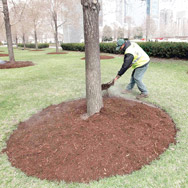Prevent frost/freeze heaving by planning now Fall is great time for mulching

By Stephanie Hughes
OSU Extension master gardener volunteer
Last winter brought lots of freezing and thawing – and we saw lots of heaving damage brought into the clinic last spring.
Now is the time to prevent this heaving, which causes extension damage to roots of perennials in the garden and landscape.
Protecting plants from cold damage – winds, heavy snow, freeze and thaw of soil on sunny winter days – is not that difficult.
The long-term damage from heaving is much worse than the time and effort applied now in the form of prevention.
From bark mulch to compost, many materials can be used.
Wood chips, straw and pine needles can help as well.
One of the major differences will be the thickness of the mulch.
Be sure not to apply more than 3 inches of any material around plants and avoid making a volcano shape up against tree trucks. This practice only makes problems worse.
Adding mulch in the fall will keep moisture in the soil.
During winter’s freeze and thaw cycles, soil lifts (as water expands when it freezes), lifting plants with it.
Mulch retains moisture – and keeps soil temperatures higher to help prevent this heaving.
As soil expands – freezes – it heaves up the plant. Then when it contracts – thaws – the plant is left above the soil line.
This exposes roots to wind and colder temperatures, damaging your plants for the next season.
Leaves as mulch are especially effective as they trap insulating air, thus allowing the soil to breathe, while protesting the plants.
High clay regions, with its water holding capacity, are very susceptible to this heaving.
Many plants can be heaved right out of the ground.
Plants that have heaved less than 1 inch can reseat themselves.
Additional mulch might be necessary to protect these tender roots.
Plants that have heaved more than 1 inch must be replanted in hope of saving them.
They may green up, but later in the summer they may die.
Evergreens tend to lose moisture through needles, scales, and leaves all winter, so cells draw moisture from the plant itself, causing winterkill (a phenomenon noted for browning and dying of limbs).
Thus, proper use of mulch and fall irrigation (since it has been dry this fall) will do a long way in keeping your evergreens healthy.
For lots of ideas on types and applications of mulches in the home garden, visit go.osu.edu/mulchplants.
To learn more about frost heaving and prevention of it, visit go.osu.edu/frostheaving.
 43
43
